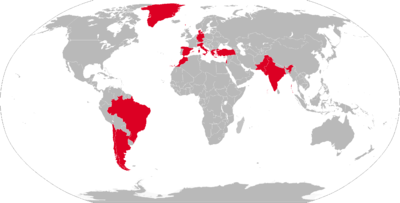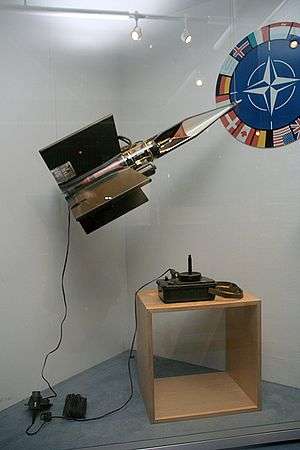Cobra (missile)
| Cobra | |
|---|---|
|
Cobra missile | |
| Type | Anti-tank missile |
| Place of origin |
Switzerland West Germany |
| Service history | |
| In service | 1957 - 1968 (Cobra) |
| Used by | See Service History |
| Wars | Six-Day War, Indo-Pakistani War of 1971 |
| Production history | |
| Designer | Contraves, Oerlikon and Bölkow |
| Designed | 1954 |
| Number built | ~170,000 |
| Variants | Cobra 2000, Mamba |
| Specifications | |
| Weight |
10 kg (Cobra) 10.3 kg (Cobra 2000) 11.2 kg (Mamba) |
| Length |
950 mm (Cobra) 952 mm (Cobra 2000) 995 mm (Mamba) |
| Diameter |
100 mm (Cobra, Cobra 2000) 120 mm (Mamba) |
|
| |
| Effective firing range |
200 m to 1,600 m (Cobra) 400 m to 2,000 m (Cobra 2000) 300 m to 2,000 m (Mamba) |
Detonation mechanism |
2.7 kg warhead (Cobra) HEAT (475 mm versus RHA) or HEAT-fragmentation (350 mm versus RHA) - (Cobra 2000) 2.5 kg HEAT or HEAT-fragmentation (Mamba) |
|
| |
| Speed |
300 km/h (Cobra 2000) 500 km/h |
Guidance system | MCLOS system |
The Cobra was a Swiss/West German anti-tank missile designed by the Oerlikon-Contraves and Bölkow GmbH companies. It entered service with the German Army in the late 1950s. It was followed by the Cobra 2000 and Mamba missile systems, which were upgrades that improved the guidance system and performance of the missile. The missile had limited distribution in the United States by Daystrom Inc., a licensed U.S. distributor, chiefly for evaluation purposes (U.S. Marines were interested and evaluated the missile for purchase.)
Description
The Cobra has a cruciform arrangement of four large forward swept wings. The main body is a long cylinder, with an underslung launch booster. Each of the wings has a spoiler on the rear edge which is used to steer the missile. The warhead is at the front of the missile, behind which is the gyro and guidance circuitry which allows the missile to interpret steering instructions from the operator. Behind the guidance mechanism is the sustainer motor, around which is wrapped the guidance wire which plays out behind the missile.
The missile is normally deployed with a single operator controlling and control box linked to up to eight missiles, which can be deployed up to twenty meters away from the operator. On launch the booster fires, projecting the missile up into the air at an angle of 20 degrees. The operator then steers the missile towards the target along his line of sight using a joystick on the control box.
Development
Development of the system began in 1954 as a collaboration between Contraves, Oerlikon and Bölkow. The initials of these companies and the German word for rocket (Rakete) gave the project its name: COBRA. The first successful tests were conducted in 1956, with the West German government placing an initial order for 2,000 missiles in January 1957.
Production of the original missile ended in 1968, with a new version, the Cobra 2000 entering service. The Cobra 2000 extended the range of the missile to 2,000 meters and could be fitted with either an Anti-tank warhead or a dual purpose anti-tank/fragmentation warhead.
The Mamba was introduced in 1972 and improved the guidance system, and added a dual thrust motor with an initial low power launch mode, followed by a higher powered sustainer which allows the missile to be gathered more easily during the initial seconds of flight. Initial launch speed is just 35 meters per second, after the sustainer is engaged this increases to 140 meters per second. The missile travels faster, reducing the time of flight to its maximum range in just 17.5 seconds. Also the operator is provided with a x7 power telescope.
Service history
The weapon was widely used by NATO forces most notably West Germany and was exported to Argentina, Brazil, Chile (Mamba), Denmark, Greece, Israel, India, Turkey, Pakistan, Spain. Approximately 170,000 of the missiles were produced.
The missile saw limited use in a number of conflicts including the Six day war and the Indo-Pakistani War of 1971. The missile proved to be ineffective, as it was difficult to control and unreliable in combat conditions.
Operators

Former operators
 Argentina[1]
Argentina[1] Brazil[1]
Brazil[1] Chile
Chile Denmark[1]
Denmark[1] Germany[1]
Germany[1] Greece[1]
Greece[1] Israel[1]
Israel[1] Italy[1]
Italy[1] India
India Morocco
Morocco Pakistan[1]
Pakistan[1] Spain[1]
Spain[1] Turkey[1]
Turkey[1]
See also
References
- Owen, J.I.H. Brassey's Infantry Weapons of the World
- Pretty, Ronald T. Jane's Weapon Systems 1977. London: Jane's Yearbooks, 1977. ISBN 0-354-00541-3.
